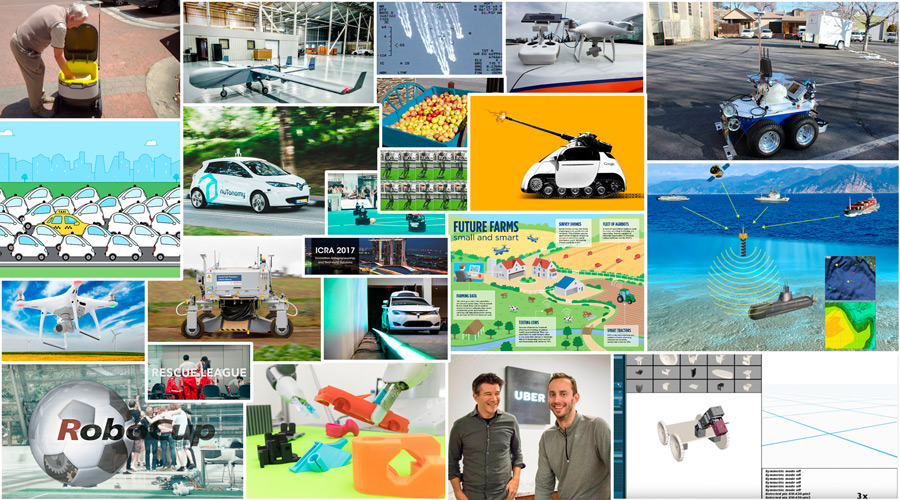
Robohub.org
Robohub Digest 05/17: RoboCup turns 20, ICRA in Singapore, robot inspector helps check bridges

A quick, hassle-free way to stay on top of robotics news, our robotics digest is released on the first Monday of every month. Sign up to get it in your inbox.
20 years of RoboCup
20 years in the books! RoboCup, which first started in 1997, was originally established to bring forth a team of robots that could beat the human soccer World Cup champions. Twenty years on, RoboCup is so more than just a soccer competition. In fact, the competition has grown into an international movement with a variety of leagues. Teams compete against each other in four different leagues and many sub-competitions, including home, work, and rescue missions. The complexity of missions in RoboCup requires intelligent, dynamic, sensing robots that can react to chaotic and changing environments. And in its 20-year history, the competition has brought forth numerous winners who have gone on to achieve great things.
Without robot competitions like RoboCup, the field of robotics wouldn’t be where it is today. So to celebrate 20 years of RoboCup, the Federation launched a video series featuring each of the leagues with one short video for those who just want a taster, and one long video for the full story. Robohub will be featuring one league every week leading up to RoboCup 2017 in Nagoya, Japan. You can watch all videos from the playlist here.
ICRA 2017 in Singapore
While we have RoboCup 2017 to look forward to, the IEEE 2017 International Conference on Robotics and Automation (ICRA) took place in Singapore. Under the conference theme “Innovation, Entrepreneurship, and Real-world Solutions”, the event brought together engineers, researchers, entrepreneurs and industry to address some of the major challenges of our times.
This year’s keynote speakers included Louis Phee, who described development and implementation of a surgical robot called EndoMaster, and Peter Luh, giving an overview of Industry 4.0. Alongside the speeches, the event included 25 workshops and tutorials, various exhibitions, as well as four Robot Challenges.
Self-driving cars: Competition heats up
May wasn’t just events and competitions. In the world of autonomous vehicles, French Groupe PSA, the second largest car manufacturer in Europe which owns brands such as Peugeot and Citroen, have teamed up with autonomous car maker nuTonomy. The collaboration will seek to build a self-driving Peugeot 3008, which they hope will hit the roads of Singapore in the not-too-distant future.
Groupe PSA and other well-known car manufacturers, including Ford Motors, who are just starting their bid to enter the autonomous car market, are lagging way behind Waymo (the self-driving car developed by Google’s parent Alphabet) when it comes to putting their cars on actual roads. And with Waymo about to team up with ride-hailing start-up Lyft, Google is getting ever closer to making their autonomous car part of mainstream traffic.
Another player in the self-driving car game we haven’t mentioned yet is cab service Uber. The company is locked in a dispute with Google over allegedly stolen design secrets and will likely be going to public trial later in the year. Linked to the lawsuit, Uber fired the engineer at the heart of the dispute, Anthony Levandowski, who is suspected of having stolen company secrets when he left Google and founded his own company, Otto, which was acquired by Uber last year. The information war continues.
Self-driving cars: Innovation
Meanwhile, a group of veterans previously linked with Alphabet founded their own company – DeepMap Inc. – which aims to develop systems that allow cars to navigate complex cityscapes.
It’s not just cityscapes that are complex to navigate. Considering other vehicles, cyclists, and pedestrians on busy roads form part of the difficult environment a self-driving car has to cope with due to its unpredictable nature. It will, therefore, become necessary for autonomous cars to understand and predict behaviour. Here, machine learning will be key, as Dr Nathan Griffiths explains in The Royal Society’s blog on machine learning in research.
And with so much interest and research into autonomous, intelligent cars, it’s not surprising that some, like Chris Urmson in a recent lecture at CMU, predict we will see a shift from the traditional transport model where people own their cars to a more dynamic, responsive model of “Transportation as a Service”, in which, companies own fleets of cars that can be used by anyone when and where they’re needed.
Robots in the fields
Much of the innovations that have enabled autonomous cars are transferable to industrial, commercial and agricultural vehicles. In the case of the latter, self-driving tractors and precision agribots have already increased productivity and made 24-hour autonomous, high-yield farming a possibility.
In Salinas Valley, California, robots are already used to pick lettuce, and to help vineyard owners decide when they need to water their plants. And GV (formerly Google Ventures) just invested $10 million into Abundant Robotics to build a picking robot, initially to pick apples but with potential for adaptation to support the harvest of other fruit.
It is believed the uptake of farming technologies is not progressing as quickly as it could be, due to farmers being slow to accept precision agriculture products, software, equipment and practices. But the farming (r)evolution is well underway, as agricultural robotics are already a 3 billion dollar industry set to grow to an impressive 12 billion by 2026.
Robots in the skies
While robots are still waiting to be fully accepted in agriculture, it’s no secret that the US military uses drones extensively. What came as a surprise was the strange video feed that surfaced in May from what appeared to be a drone flying over Florida’s panhandle, apparently sponsored by the National Reconnaissance Office – a body that doesn’t usually publicise its drone-related activities. The footage, now believed to have been shot in February, was likely uploaded as a demo video by a contractor.
While the Florida video caused quite a bit of confusion this month, another drone was making headlines for very different reasons. Previously used in military operations, the ArcticShark (a modified version of the military TigerShark) drone is now helping to fight climate change. And it’s now on a scientific mission to help scientists understand cloud formation and other atmospheric processes.
In other drone-related news, the Alaska Department of Transportation and Public Facilities has allowed some of its employees to receive licenses to operate drones to support projects involving roads, bridged and other structures. And a report has shown that drone funding fell by 64% in 2016 compared to 2015, with DJI dominating the market and issues such as battery life, connectivity problems and drone regulations stifling development efforts.
Robots in the water
From the skies to the sea: this May, NATO Nations agreed to use JANUS for their digital underwater communications. JANUS has the potential to make military and civilian, NATO and non-NATO, devices fully interoperable, doing away with the communication problems between systems and models by different manufacturers that have made underwater communication difficult up to this point.
Robots in the lab
Researchers at the Institute for Human and Machine Cognition in Pensacola, Florida, have developed a two-legged robot that can run without using sensors and a computer. The robot, called Planar Elliptical Runner, is stable through its physical design, which makes it different to other two or four-legged robots.
Meanwhile, a team at the University of California, Berkeley, has come up with a nimble-fingered robot that is able to pick up a wide range of objects using a 3D sensor and a deep learning neural network. It may not be perfect, but it’s the most nimble-fingered robot yet and the technology may find applications in picking and manufacturing in future.
Human-Machine Interaction
Most of the robots we interact with are practical helpers, offering support in the home, on the road or at work. Innovations some of us may have interacted with are autonomous lawn mowers, cars with self-driving features, or Amazon’s Alexa. With there plenty more robots in the pipeline.
A four-wheeled, waterproof, battery-powered robot inspector developed by a team in Nevada, may soon be supporting civil engineers and safety inspectors with bridge checks to reduce the chance of human error and omissions that could lead to a collapse such as the I-35W bridge disaster in Minnesota on 2007.
https://www.youtube.com/watch?v=kUXC7vMjEa8
And finally, engineers in Germany have built a robot priest called BlessU-2 that can beam light from its hands and deliver blessings in five languages. The robot is meant to spark discussions about faith, the church and the potential of AI.
Learning resources: Robot Academy
And to finish off our digest for May, we wanted to highlight a new open online resource for robotics education: the Robot Academy. Developed by Professor Peter Corke and the Queensland University of Technology (QUT), the Academy offers more than 200 lessons from robot joint control architecture to limits of electric motor performance. So if you find yourself with a bit of time on your hands, why not try a Robot Academy Masterclass?
Or if you’re after something a little bit different, there’s a new toolkit on “Computational Abstractions for Interactive Design of Robotic Devices” that allows you to drag and drop parts of a virtual robot on screen without the need to know exactly what needs to connect to what as a complex physics engine ensures your robot won’t fail or fall over.
Missed any previous Digests? Click here to check them out.
Upcoming events for June – July 2017
Intelligent Ground Vehicle Competition: June 2-5, Rochester, MI.
CES Asia: June 7-9, Shanghai, China.
Unmanned Cargo Ground Vehicle Conference: June 13-14, Maaspoort, Venlo, The Netherlands.
Autonomous machines world: June 26-27, Berlin, Germany.
RoboUniverse: June 28-30, Seoul.
CIROS: July 5, 2017 – July 8, 2017, Shanghai, China.
ASCEND Conference and Expo: July 19, 2017 – July 21, 2017, Portland, OR
RoboCup: July 25, 2017 – July 31, 2017, Nagoya, Japan
Call for papers:
1st Annual Conference on Robot Learning (CoRL 2017): Call for papers deadline 28 June.
tags: Robohub Digest






